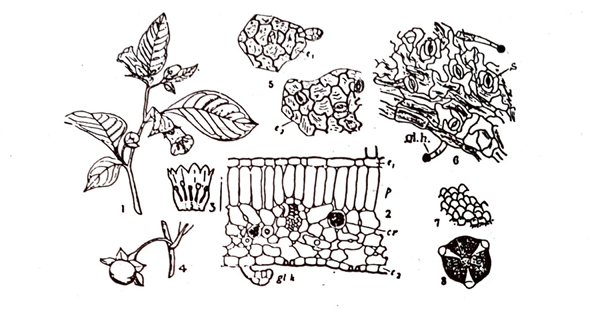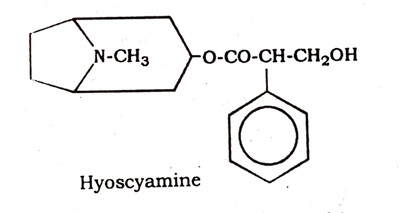Synonyms: Belladonna Herb, Belladonna Leaf, Belladonnae Herba, Deadly Nightshade Leaves, Foha Belladonnae
Botanical source: Belladonna consists of the leaves and other aerial parts of Atropa belladonna Linn. of the family Solanaceae, collected when the plant is in flower.
Geographical source: The plant is indigenous to central and southern Europe and is cultivated in England, other European countries and the United States of America.
Macroscopical characters: Belladonna leaves are simple, broadly ovate to ovate-lanceolate with short petioles, 6 to 20 cm long and 2.5 to 12 cm broad, venation pinnately reticulate; margin entire, apex acuminate, surface slightly hairy, colour yellowish green, green or brownish green, texture thin and brittle; odour slight, taste bitter and acrid. Flowers are tubular, about 2 cm long purple or brownish yellow calyx five-lobed, corolla campanulate, five-lobed; stamens five epipetalous; ovary superior and bilocular. Immature fruits are sub-globular berries, green to greenish brown, about 12 m1n in diameter; seeds are numerous, flattened, reticulate and brown in colour.
Microscopical characters: Leaf epidermal cells of both surfaces possess sinuous walls and striated cuticles. Stomata are present on both surfaces, but more numerous on the lower. surface, typically cruciferous (anisocytic). Both clothing and glandular trichomes are present. Clothing trichomes are simple, uniseriate; two to four cells in length. Glandular trichomes have uniseriate stalks and unicellular heads. Palisade consists of a single layer of cells. Microsphenoidal crystals of calcium oxalate occur in the mesophyll. An are of collateral vascular bundle occurs in the midrib. Steam epidermal cells are provided with striated cuticle, both covering and glandular trichomes are present on them. Other tissues of the stem include an endodermal starch sheath, reticulate vessels with bordered pits and pericyclic and xylem fibres. Microsphenoidal crystals of calcium oxalate occur in the pith. Calyx possesses a high proportion of glandular trichomes.
Inner epidermis of corolla is papillose. Subspherical pollen grains often occur.

Fig. 13: Belladonna, 1, habit sketch of flowering top; 2, t.s. of leaf-lamina; 3, corolla with epipetalous stamens; 4, young fruit; 5, epidermises of leaf; 6, outer epidermis of a sepal; 7, papillose epidermal cells of corolla; 8, a pollen grain. er, idioblast with microsphenoidal crystals; e1 & e2 upper and lower epidermis; gl, h., glandular trichomes; p, palisade; s, stoma. (Reconstructed from Wallis).
Chemical constituents: Belladonna contains b.2 to 0.6 percent of tropane alkaloids, the principal one being hyoscyamine. It also contains small amounts of some other tropane alkaloids and some volatile bases.

Uses: Belladonna is used externally as a painkiller and internally to check excessive secretions, as a sedative and antispasmodic. It is a mydriatic and parasympatholytic drug and also acts as a local anaesthetic and anodyne.
Substitutes and adulterants: Common substitutes and adulterants of Belladonna include the dried leaves of Solanu.m dulcamara (Solanaceae), Scopolia camiolica (Solanaceae), Phytolacca decandra (Phytolaccaceae) and Ailanthus altissima (Simaru baceae).

